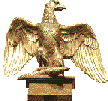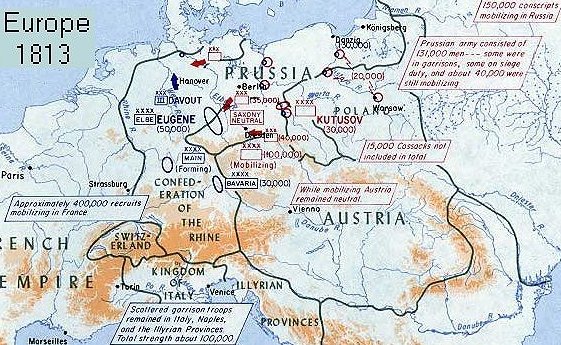
Battle of Hagelberg.
27th August 1813.
The Cossacks and Prussian Landwehr inflicted 6.000 casualties
on the French regulars. Their own losses were 1.500 killed and wounded.

 1. Itroduction.
1. Itroduction.
2. Troops.
3. Battle.
4. Aftermath.
5. Sources and Links.
On photo: Battle of Hagelberg 1813 memorial. Source: de.wikipedia.org
Introduction.
The strategical situation in the beginning of 1813 was complicated. While Marshal Oudinot's army moved towards Gross-Beeren, Girard's infantry division sought to join him. The Prussians seeking information on Girard sent out patrols and Hirschfeld's force to engage the French. General-Major Karl Friedrich von Hirschfeld received news that Girard's division was in camps near Lubnitz and Hagelberg. The Cossacks were immediately sent to Belzig.
"Die Schlacht bei Hagelberg ereignete sich in der Folge
der Schlacht bei Großbeeren und im Vorfeld der Völkerschlacht
bei Leipzig während der Befreiunskriege."
"Die Schlacht von Hagelberg wurde zum Symbol für den Widerstand
gegen das napoleonische Herrschaftssystem in Deutschland."
- www.brandenburg.de/land
the War of Liberation. Public demonstrations
in Prussia against the French persuaded
the king of Prussia, Frederick William,
to change sides.

The Prussians received news that a French division
was in camps near Hagelberg. The Cossacks were
immediately sent, and the Prussians followed them.
 "Germany, and particularly Prussia, suffered more than other German regions under French rule following the dramatic Prussian-Saxon defeat of 1806-07. The hatred of France and all things French was more developed in political discourse there than elsewhere in Germany. The patriotic-national mobilization for the ‘War of Liberation’ in 1813 extended beyond the small elite of the educated strata." (- Karen Hagemann, Wales)
"Germany, and particularly Prussia, suffered more than other German regions under French rule following the dramatic Prussian-Saxon defeat of 1806-07. The hatred of France and all things French was more developed in political discourse there than elsewhere in Germany. The patriotic-national mobilization for the ‘War of Liberation’ in 1813 extended beyond the small elite of the educated strata." (- Karen Hagemann, Wales)
The war in 1813 was called by the Prussians, the War of Liberation.
Public demonstrations in Prussia against the French persuaded the king of Prussia, Frederick William, to change sides. Austria declared war on France in August. The combined allied armies were nearly half million strong and were commanded by Bernadotte, Blucher, Barclay de Tolly, Bennigsen, and Schwarzenberg. The Saxon Campaign in 1813 is one of the greatest Napoleonic Campaigns. It includes such battles like Lützen, Bautzen, Hanau, Dresden, and the mighty Battle of the Nations at Leipzig.
 Napoleon's victories at Lützen and Bautzen were indecisive and the Prussians welcomed the armistice of June 4 as a chance to strengthen their army. The Prussian Landwehr completed its basic training and was considered ready for action, swelling the army's ranks. The Landwehr only recently received their muskets. Although they were considered second rate troops they were strongly motivated to liberate their country.
Napoleon's victories at Lützen and Bautzen were indecisive and the Prussians welcomed the armistice of June 4 as a chance to strengthen their army. The Prussian Landwehr completed its basic training and was considered ready for action, swelling the army's ranks. The Landwehr only recently received their muskets. Although they were considered second rate troops they were strongly motivated to liberate their country.
|

Troops.
Prussian General Hirschfeld had the following regiments at Hagelberg: Although the Landwehr in 1813 was second rate troop, they were highly motivated. The Prussian Landwehr was based on the model of that of Austria of 1809.
Loraine Petre writes: "As the impoverished state of Prussian finances precluded much assistance from the State, the expense of equipment had to fall on the men themselves, or their villages. ... At first, the front rank was often armed with pikes or scythes, and it was only as French muskets were taken from the battlefields that the men were armed with yet another pattern of firearm. There was a great dearth of officers, as most of the half-pay officers still fit for service were required for the reserve battalions.
The French were commanded by seasoned Général de Division Jean-Baptiste Girard (1775 - 1815).
In 1813 the French army was made of young recruits (the battle-hardened veterans perished in Russia few months earlier). General Savary writes: "Evidently, some of the new troops looked so bad
in drill while still at the training centers that the populace referred to the army as the 'infants of the Emperor."
|
|

The Battle.
Hirschfeld issued the following order:
"The combined cavalry, except for von Bornstadt's squadron, shall march to the left under the command of Oberst (Colonel) von Bismark. The Fusilier Battalion of the 1st Reserve Regiment shall lead, followed by two musketeer battalions of the regiment.
As the Landwehr cavalry began to advance toward the French, they were raken by artillery fire. The French advance guard was not about to yield without a fight. The 5th and 6th Kurmark Landwehr attacked driving back the French infantry and scattering the French cavalry. The debris of the French advance guard fled back on the main body of Girard's forces behind Lübnitz. The Prussian cavalry followed them and had completely disbanded itself in the process. One Landwehr battalion moved through the streets of the burning village pursuing the enemy. Two French battalions took cover behind a wall and opened fire on the cavalry. The casualties however were very light. The Prussian reserve infantry (see picture) followed the Landwehr cavalry and infantry. The 1st Reserve Infantry had 2,882 men in 4 battalions, and was one of the strongest Prussian units on the battlefield. Three of its battalions were part of the advance guard commanded by Major von Langen. The fourth battalion led von Puttlitz's brigade.
Only after the French battery withdrew the Prussians continued deploying their troops. Major von Langen took 1st Reserve and 4th Kurmark Landwehr and entered the Belzig Wood in order to turn the French flank. To avoid being outflanked the French fell back and deployed on the hill near Hagelberg. While Cossacks led by Alexandr Ivanovich Chernishev advanced against Girard's flank, the seven Prussian battalions moved between the Belzig and the Birken Woods. The French opened fire but without much effect, they were driven off from the hill and pushed into Klein-Glien. At 3 pm the Prussians placed the bulk of their Landwehr on the edge of the woods while the main French force stood west of Klein-Glien.
The Cossacks defeated cavalry
Landwehr battalion fled The Prussian Landwehr attacked several times. The first line of the attackers consisted of battalion of 3rd Landwehr and battalion of 1st Reserve Infantry. The Prussians passed through the skirmish chain and deployed into line to exchange fire. The French line held their ground and opened rapid musket fire. After 3 minutes of musketry the Landwehr battalion had enough and fled "carrying the other battalions back with them." To modern man, long accustomed to repeating and automatic firearms, one, 2 or even 3 rounds per minute is nothing to write home about. However, once one comes to grips with the idea of 600 men, packed into front of about 200 paces, able to fire anywhere from 1000 to 3000 rounds per minute, then the image alters drastically, even in the eyes of a modern soldier.
Hirschfeld's general advance
Hirschfeld ordered a general advance by the right wing, storming the Hagelberg hill.
Two French battalions counterattacked and colided with three Landwehr battalions and three squadrons. The French fell back with the Landwehr hot on their heels. The Landwehr surrounded one French battalion in the garden. The French with 2 guns surrendered. Another French battalion and small troop of cavalry still kept fighting in the streets. The 3rd Kurmark Landwehr advanced into a plowed field surrounded with a stone wall, which stood next to the village. The French exchanged volleys with them and withdrew into the village. Girard's division fell back.
Meanwhile the single Cossack regiment was joined by freshly arrived four regiments of the bearded warriors. In this situation Girard's division fell back on Klein-Glien and abandoned the Hagelberg hill. The Cossacks drove the French hussars off. Two French battalions were retreating when 500 Cossacks, 300 Prussian riflemen and several Russian guns struck at them. Approx. 1,030 Frenchmen surrendered. Landwehr cavalry followed the retreating enemy. Girard's division withdrew from Gross-Glien in two columns, one column marched towards Magdeburg. The roads were filled with fleeing soldiers, and here and there were piled up baggage wagons, and abandoned weapons. |

Sources and Links.